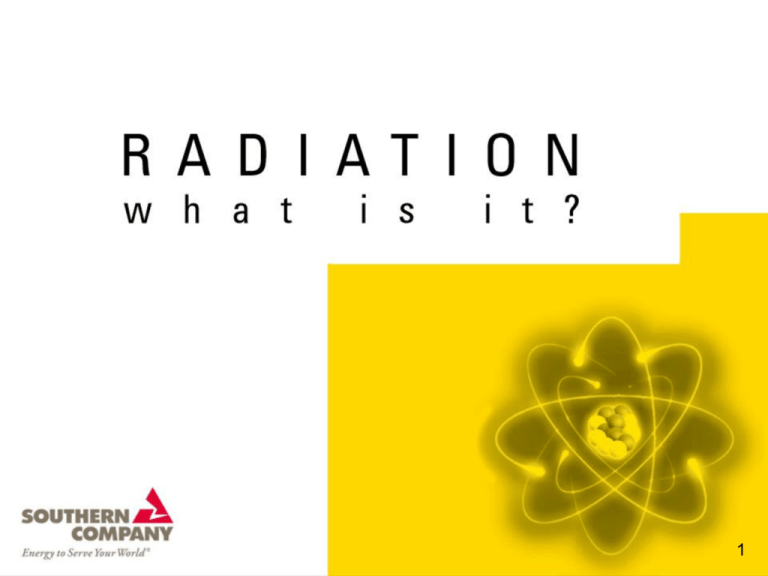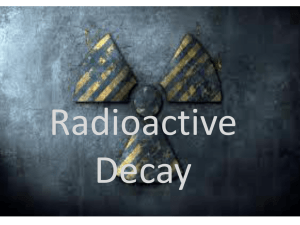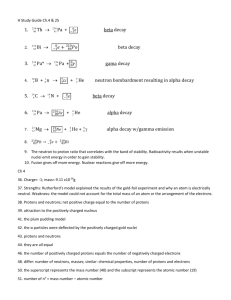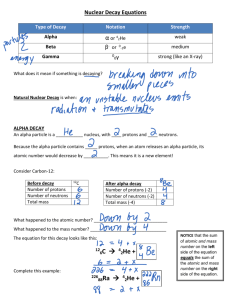MS PowerPoint Presentation
advertisement

1 2 3 RADIATION Energy in the form of particles or electro-magnetic waves emitted from the nuclei of unstable atoms 4 RADIATION The term really includes all forms of electromagnetic radiation Commonly used today to describe particulate radiation 5 NUCLEAR REACTIONS PRODUCE RADIATION Protons and neutrons determine nuclear reactions One must understand atomic structure to understand radiation 6 NUCLEAR PARTICLES Protons and Neutrons are the two basic nuclear particles. Together they contain practically all the mass of an atom and are determinants of an atom’s nuclear characteristics. 7 RADIOACTIVE DECAY • Radioactive decay refers to the spontaneous emission of radiation from the nucleus of an unstable atomic nucleus • The ratio of neutrons to protons is largely determinant of the stability of the nucleus and the tendency for radioactive decay to occur 8 DEFINITION OF RADIOACTIVE DECAY “Radioactive decay is the process of spontaneous emission of radiation in the form of particles or photons from the nuclei of unstable atoms” 9 CHARACTERISTICS OF RADIOACTIVE DECAY • It is a natural process in our universe • It is spontaneous – we cannot predict when an atom will undergo decay 10 BASIC TYPES OF RADIOACTIVE DECAY Alpha () decay • Occurs when atomic nuclei have too many protons and neutrons (i.e., Are heavy) 11 ALPHA PARTICLE 12 CHACTERISTICS OF ALPHA PARTICLES • • • • • Consist of 2 protons and 2 neutrons Mass of an alpha particle is ~8000 me or 4 amu Charge = +2 Are highly ionizing Have low penetrating abilities (only cm in air and mm in water) 13 MORE ABOUT ALPHA PARTICLES • Easily shielded; common types of shielding are paper, cardboard, air, clothing; will not penetrate skin • Health hazard when taken internally • Not commonly used in medicine • Common sources = smoke detectors (Am-241) and lantern mantles (thorium nitrate) 14 ALPHA PARTICLE DECAY • Changes both the mass and identity of the nucleus of the parent radionuclide • This means that the decay results in the formation of a new element as the daughter product 15 QUESTIONS? 16 NEGATIVE BETA (ß-) DECAY Occurs when atoms have too many neutrons (i.e., Are “neutron-rich”) and decay by emitting a negative beta particle (ß-) 17 WHAT ARE NEGATIVE BETA PARTICLES? During negative beta decay, excess neutrons are converted into protons, electrons, and antineutrinos. The protons remain in the nucleus but the new electrons are emitted as negative beta particles (ß-) or negatrons. You may wish to think of them as “nuclear electrons.” 18 CHARACTERISTICS OF NEGATIVE BETA DECAY • Less ionizing than alphas due to decreased mass of negatrons • Changes the identity of the nucleus but not the mass • The z number is increased due to conversion of neutrons into protons 19 CHARACTERISTICS OF NEGATIVE BETA PARTICLES (NEGATRONS) Negatrons consist of nuclear electrons The mass is the same as electrons There is a charge of –1 in negatrons More penetrating than alpha particles; ~ 12 meters in air They can penetrate skin– best shielding is wood, plastics, thick cardboard, etc. 20 POSITRON + (ß ) EMISSION Occurs when the nucleus of the atom has too many protons (i.e., is proton-rich). It is also known as positive beta decay. 21 POSTIVE + BETA (ß ) DECAY Results in a positive electron emitted from the nucleus of the proton rich atom. This positive electron is known as a positron. An additional particle, a neutrino, is also emitted from the nucleus. Neutrinos are very small particles with no electric charge. They have little or no mass and participate in weak interactions. 22 CHARACTERISTICS OF POSITRON EMMISION Positrons have same mass as electrons Positrons have charge +1 Positrons are less ionizing than alphas Positrons are more penetrating than alpha decay but less than gamma The best shielding is lead with thickness of 1 inch or more 23 QUESTIONS? 24 GAMMMA () EMISSION Is a form of pure electromagnetic radiation emitted from nuclei that have excess energy. It is sometimes called gamma photon radiation. 25 GAMMMA RAYS Are photons emitted from unstable nuclei to rid themselves of excess energy. Gamma photons are subatomic packets of pure energy. They are higher in energy and more penetrating than the photons that make up visible light. 26 GAMMMA RAYS AND X RAYS Have the same properties except for their origin Gammas come from within the nuclei of atoms X-rays come from outside the nuclei Both are electromagnetic energy in the form of emitted photons 27 PROPERTIES OF GAMMMA () AND X RAYS Charge is 0 (no charge) Mass is 0 (no mass) Low ionization Penetration abilities can be extremely high; – penetrating power is dependent upon the energy of the emitted photons 28 QUESTIONS? 29 TERMS TO REVIEW Radiation Alpha particle Negatron Positron Gamma ray Positive beta decay Antineutrino Alpha decay Radioactive decay Negative beta decay X-ray Photon 30 TEST YOUR KNOWLEDGE #1 Which of the following particles has the most mass? A. Negatron B. Gamma photon C. Positron D. Alpha 31 TEST YOUR KNOWLEDGE #2 Which of the following does not penetrate human skin? A. Alpha radiation B. Positron emission C. X-rays D. Gamma rays E. Negatron radiation 32 TEST YOUR KNOWLEDGE #3 Radioactive decay is a spontaneous process. A. True B. False 33 TEST YOUR KNOWLEDGE #4 Which of the following has no mass and no charge? A. Alpha particles B. Gamma rays C. Negative beta particles D. Positrons E. No correct answer given 34 TEST YOUR KNOWLEDGE #5 What type of radioactive decay occurs because of proton rich nuclei? A. Gamma B. Positive beta C. Alpha D. Negative beta E. X-ray 35 Want to Know More???? Arrange a visit to a nearby Nuclear Facility or search the WWW. Farley Nuclear Plant Visitors Center near Dothan, AL 1-800-344-8295 http//:www.southerncompany.com 36







